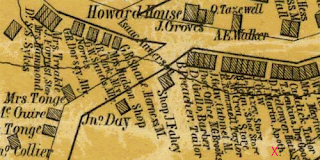
Edwin Abbey (1852-1911), who would gain fame painting large murals while living in England, visited his father’s sister and her husband Dr. Isaac J. Martin in Ellicott City during summers. In July 1864 the Union army lost the Battle of Monocacy, near Frederick. Troops
under Lew Wallace marched down Main St. followed by the three officers, walking leading their horses.
Lew Wallace (1827-1905) held several posts after he resigned from the Army, including Governor of New Mexico Territory and then US Minister to Turkey (Ottoman Empire). But his fame is from the book he wrote - Ben-Hur, published in 1880, and the epic film in 1959.
Abbey watched the wearied soldiers on Main St, Ellicott's mills while on a "granite block in front of Martin’s drug store" which was owned by his uncle. "I J Martin, Apoth" X at bottom right of 1860 mapLew Wallace (1827-1905) held several posts after he resigned from the Army, including Governor of New Mexico Territory and then US Minister to Turkey (Ottoman Empire). But his fame is from the book he wrote - Ben-Hur, published in 1880, and the epic film in 1959.
According to his cousin Roswell Abbey Martin, the same age – “Gen. Lew
Wallace’s Union troops passed through Ellicott City on their retreat from the
battle of Monocacy, and the whole town was stirred over the presence of the
soldiers, the Southern sentiment being very strong. Edwin’s Northern sympathies had brought him
into many conflicts with the boys in town.
The bedraggled appearance of Wallace’s troops had a humorous side which
struck Edwin forcibly. Some of the men
wore coats, others did not. A few
carried muskets, others rifles, while still more trudged along, with no
firearms at all. They were generally a
sorry lot.
The First “Moving Picture.”
Edwin made a series of small drawings which he pasted on a long strip
of paper and wound around two pieces of a broomstick, placing the whole in a
box with a glass top. It was really a
moving picture, probably the first, and the residents of Ellicott City were
permitted to view Abbey’s impressions of the soldiers by paying ‘an admission
of a pin apiece.’
The Sun Aug 2, 1911
“Admiral” Edward P. Duffy, was part of a “little company of boy
soldiers”, became a writer and on editorial staff of the Baltimore Sun wrote an
article in the Sun on April 28, 1907.
“On July 11 [1864] the main column of the retreating army began
entering the town. The street was
crowded with sightseers. Standing upon a
granite block in front of Martin’s drug store was a little fellow, fair of
face, shoes smile always brought out a dimple on each side of his pleasant
mouth. He watched with deep interest the
moving soldiers as if drawing inspiration from the scene. The last of the troops having passed, some
distance behind them were three officers, each leading his horse by the
reins. This trio closed the passing
panorama of a defeated army.
The central figure of the three officers was Gen. Lew Wallace, later United States Minister to Turkey and author of Ben-Hur” and “The Prince of India.” The boy, who gazed upon his retreating legions, was Edwin Austin Abbey, who was destined to become one of America’s most famous painters and artists. …
The central figure of the three officers was Gen. Lew Wallace, later United States Minister to Turkey and author of Ben-Hur” and “The Prince of India.” The boy, who gazed upon his retreating legions, was Edwin Austin Abbey, who was destined to become one of America’s most famous painters and artists. …
Soldiers on crutches, arms in slings and heads in bandages were mosaicked in to complete the impression received by the embryo artist two days before. We were allowed to see this picture, which had been mounted at each end on rollers, and as manipulated made a moving panorama.
Here Abbey brought out the commercial side of his nature. After the opinions passed by his critics –
which I am sure, were much more enthusiastic than a Royal Academy commendation –
it was decided to exhibit the marvelous picture at “one pin to see the show.” –
Everybody in the town that could raise a pin added their encomiums to the
production of Master Abbey. He gathered
in the price of the “see” faster than he could stick them into the lapels of
his coat.
Donated to Hospital
It may be credited to the artist that he donated all the receipts of
the show to the medical corps of our organization to secure the bandaged wounds
received by my troops [group of boys acting as soldiers] whose marches made
sore feet, and especially “stubbed toes.”
Abbey and his cousin, Roswell Abbey Martin, were the only members of the
command whose parents could afford to have them wear shoes seven days in the
week. …Baltimore Sun. April 28, 1907
According to the article Abbey lived during his first four years in Ellicott's mills at the site of the home owned in 1911 by Dr. M. Gist Sykes. “Thanksgiving among the early Puritans” picture done when he was about 12, was published
in Harper’s Weekly. He worked for them
until moving to England where he remained, even changing his citizenship, until
his death in 1911.
©2019 Patricia Bixler Reber
Forgotten history of Ellicott City & Howard County MD


No comments:
Post a Comment